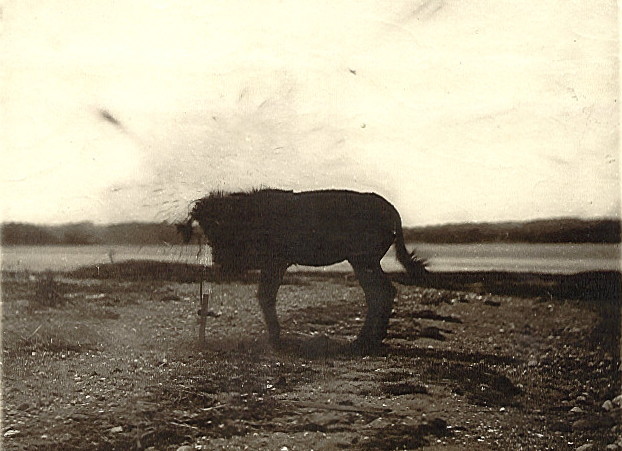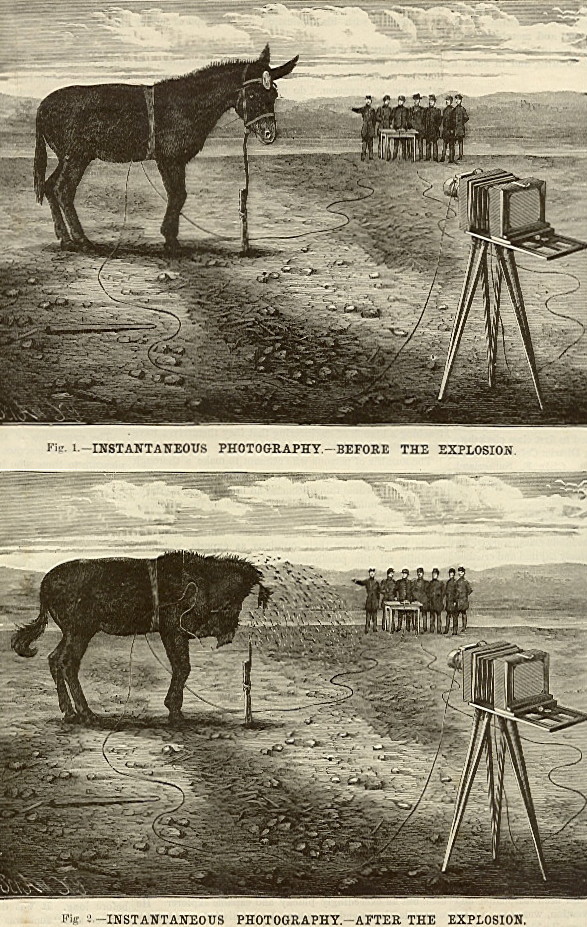Photographing a mule at the instant its head is blown off by dynamite
Advances in photographic technology that occurred in the 1860s and 70s led to the invention of plates that had exposure times of a fraction of a second. This allowed for "instantaneous photography," as it was called at the time. Moving objects could be frozen in time by the camera.
Researchers immediately used this technology to study bodies in motion. Most famously, Eadweard Muybridge in 1878 took a series of images to study the galloping of a horse. Similarly, neurologist Jean-Martin Charcot used instantaneous photography to study the muscular movements of his human patients.
A more unusual application of the technology took place on June 6, 1881, when Mr. Van Sothen, photographer in charge at the United States School of Submarine Engineers in Willett's Point, New York, took an instantaneous photograph of a mule having its head blown off by dynamite. The mule was apparently old and was going to be put down anyway, so it was decided to "sacrifice the animal upon the altar of science."

Eugene Griffin, First Lieutenant of Engineers, described the details of the experiment in a letter to Lieut. Col. H.L. Abbot:
Several months later Scientific American published an account of the experiment, including several engravings showing before and after scenes:

Researchers immediately used this technology to study bodies in motion. Most famously, Eadweard Muybridge in 1878 took a series of images to study the galloping of a horse. Similarly, neurologist Jean-Martin Charcot used instantaneous photography to study the muscular movements of his human patients.
A more unusual application of the technology took place on June 6, 1881, when Mr. Van Sothen, photographer in charge at the United States School of Submarine Engineers in Willett's Point, New York, took an instantaneous photograph of a mule having its head blown off by dynamite. The mule was apparently old and was going to be put down anyway, so it was decided to "sacrifice the animal upon the altar of science."

The resulting photo
Eugene Griffin, First Lieutenant of Engineers, described the details of the experiment in a letter to Lieut. Col. H.L. Abbot:
On the 6th of June, 1881, an instantaneous view was taken, by your direction, of the execution of a condemned mule belonging to the Engineer Department. A small bag containing 6 ounces of dynamite and a fuse was fastened on the mule's forehead, the wires from the fuse connecting with a magneto-electric machine. The camera was placed at a distance of about 47 feet from the mule and properly focussed; the drop shutter was held up by a string, fastened to another fuse, which was placed in the same circuit with the first, so that both were fired simultaneously and the shutter allowed to drop. The result was a negative showing the mule in an upright position, but with his head blown off. This photograph has excited much interest and comment in the scientific world. A very narrow slit was used in the shutter, and as nearly as can be estimated the time of exposure was about 1/250 of a second. A 10 by 12 gelatino-bromide instantaneous Eastman dry plate was used, with a 4 D Dallmeyer lens, using the full opening.
Several months later Scientific American published an account of the experiment, including several engravings showing before and after scenes:

Scientific American - Sep 24, 1881
Comments
Commenting is not available in this channel entry.

Category: Mad Scientists, Evil Geniuses, Insane Villains | Photography and Photographers | Science | Experiments | Nineteenth Century